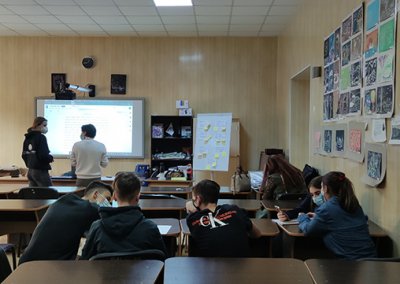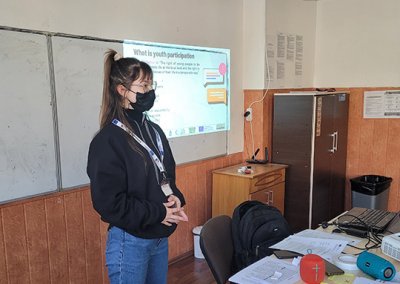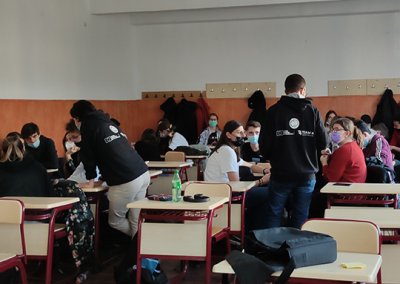Active participation
First of all, this workshop was not new for us. On Wednesday 9th February, we continued to improve the “active participation” workshop we introduced the day before. This time, we did it in front of a smaller number of students. In total, twelve 9th grade students were present, from class 9B.
In a nutshell, to do “active participation” means to have an impact on your community or society by expressing yourself. Our workshop is focusing on online active participation, which suits the students’ communication habits more. It lasted 40 minutes.
Fewer students, more exchanges
Similar to our previous workshops, we started with an icebreaker activity. We also played the “broken phone” game. Students had to get up, get in front of each other and form two lines. We whispered to them a sentence. They had to repeat it from the beginning of the line to the end. However, we played loud music in the class to make it harder.
The sentence was : “There is a fine line between participation and mockery”.
They managed to keep the sentence intact, with one exception: the word “mockery”, which they didn’t know then. We’re happy to improve their English level if we can! 😅
After that, our French volunteer Lisa explained the topic of the day. Then, we started our first playful activity. As we wrote above, what changed this time is the number of students: two groups of five students. Obviously, it was easier to get their attention.
Interactions, MORE interactions
On the whole, this activity was the same as before. We stuck seven written examples of online participation to a board and we gave them multiple “right” and “wrong” sticky notes. Théo explained the rules: each group had to decide whether each example is considered “active participation” or not. Then, each group sent someone to the board to stick their votes on each sentence. Some examples :
- Signing an online petition
- Send an email to a parent
- Sharing a song you recorded on TikTok …
However, we tried to interact more with them while they were working on it. Doina and Théo went to see each group to discuss what they understood about the activity, or if they had doubts. Like the day before, the students had the obvious ones right (e.g. Signing an online petition) but falsely thought that expressing their art or opinions on TikTok and Instagram didn’t count as active participation. By playing, they learned the boundaries of this concept and that they were already doing it.
Fewer students, more exchanges
Next, we started our second educational activity: the study case. Again, we told them a fictional story about a girl from their high school who fell on staircases in front of many students. Her stunt was filmed and massively shared among youngsters. At first, she laughed about it, but it eventually affected her morally. We asked them to react to this not-so-obvious cyberbullying case.
Although, this time, we also went to exchange with each group separately before they gave their final answers. On the question of sharing or not the video themselves, one student thought it was harmless if he only showed it to his close friends on his phone, without sharing the video file itself. However, this exchange pushed one girl in his group to say that she didn’t agree with this.
More than that, the question about how they could actively participate to have an impact on this story led to a debate. Precisely, between us, the students and their teacher. No easy solution stood out. Yet, this kind of interaction allowed us to go deeper into our topic of the day. We really liked it, as well as the students, according to their feedback! We’ll do that again for our next workshop!
Improving our next workshop
Two days later, we also presented the “active participation” workshop for a new class we had never met before. On Friday 11th of February, we got back to work with a larger class at Mihai Eminescu high school. Precisely, in front of 22 students from 10th grade’s class D. We only changed the sentence for the broken telephone icebreaker and the activities went smoothly. However, we managed to implement the interactive methods that worked on Wednesday to a larger group of participants.
Again, the students really liked it, according to the feedback sheets we gathered at the end. The class was really dynamic. They thanked us for keeping them interested all along! One student even asked us to talk more about youth and politics. In fact, we mentioned briefly during the right-or-wrong activity with sticky notes. Good suggestion! We will think about it for the next workshop 👩🏫
Location: Mihai Eminescu high school, Constanta, Romania
Date: 9th and 11th of February, 2022
Want to see more about our Erasmus events?
Build confidence | Recognize own abilities | Broaden horizons




